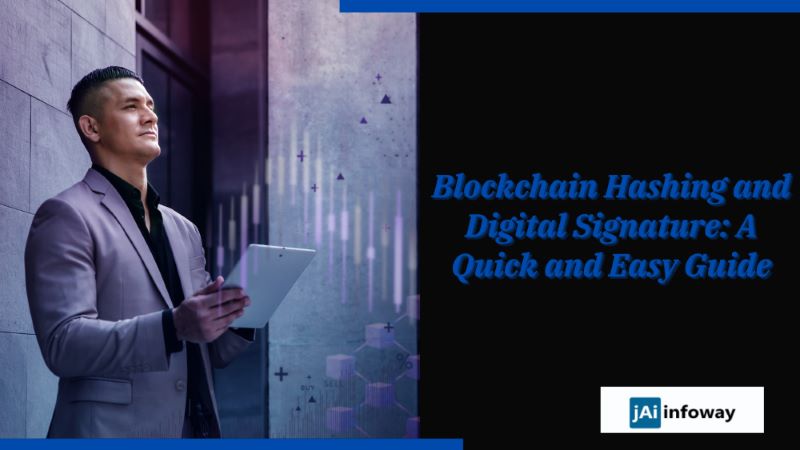The problem of hashing and digital signatures in the blockchain is essential for customers, companies, and even engineers.
Data is all that the world of the twenty-first century consumes. Well, it appears that you already know what I mean. Every day brings a greater reliant on data for everything and everyone. In addition, economies are swiftly moving away from oil-driven models and toward data-driven ones.
These days, data and information are practically everything. Governments, corporations, and even individuals are already making daily decisions that rely largely on data. Data has become such a valuable resource that attackers prefer it over all other options.
However, relying extensively on data raise serious issues including privacy and security. Both the need for data and the requirement for security go hand in hand.
We’ll explain blockchain hashing and blockchain Digital signature in this article and explain how they function. So let’s get started!
Blockchain to the Rescue: Digital Signature and Hashing
Today’s businesses are looking for creative solutions to protect information. Blockchain is one method that businesses have discovered. Blockchain technology has changed how business done and how data is saved and safeguarded.
Information security techniques like cryptographic hashing and blockchain digital signatures used in blockchain technology. Blockchains are not the only technology for digital signatures and cryptographic hashing. However, they improve the security systems with distributed ledger technology.
Let’s examine what hashing and digital signatures have to say.
What Does the Blockchain Mean by Hashing and Digital Signature?

The idea of hashing is the idea of taking any amount of input data, running it through an algorithm, and producing a fixed-size output data set called the hash. A single character, an MP3 file, a whole book, a spreadsheet of your financial transactions, or even the entire Internet might represented by a small number of bits in the input. The key concept is that the input is infinitely large. There are various publicly available hashing algorithms, and you can select one based on your needs. The crucial aspect is that the method generates a finite number of bits from an infinite input of bits after performing some calculations on them. 256 bits, as an illustration.
What purposes may this hash serve?
Using hashes to fingerprint files, also known as check zones, is a prevalent practice nowadays. In other words, a hash is employed to confirm that a file has not been altered or changed in any way that was not intended by the author. For instance, if WikiLeaks publishes a set of files along with their MD5 hashes. Anyone who downloads those files can confirm that they originate from WikiLeaks by computing the MD5 hash of the downloaded files; if the hash differs from what WikiLeaks published, then you know that the file was altered in some way.
How are hashes used in the blockchain?

Blockchains employ hashes to represent the status of the world right now. The output hash, which reflects the current state of the blockchain technology, is generated from the input, that is the complete state of the blockchain, or all of the transactions that have occurred to date. The hash establishes consensus among all parties that the global state is the same.
How are these hashes determined in reality?
The transactions contained in the first block, also known as the Genesis block, are used to create the first hash. For the Genesis block, a block hash is calculated using the original transactions’ order. The hash of the preceding block is also utilized as input to calculate the block hash of each subsequent block that is generated, along with the block’s transactions. A chain of blocks is created in this way, with each new block’s hash pointing to the one before it.
The method of hashing ensures that no transaction in the history can be altered because, if any one component of a transaction is changed, the hash of the block to which it belongs will also change, as will the hashes of any succeeding blocks as a result. As a result, it would be rather simple to detect any manipulation since all you have to do is compare the hashes.
It is interesting because everyone on the blockchain can agree on 256 bits to represent the blockchain’s potentially endless state. The Ethereum blockchain presently occupies tens of gigabytes, but at the time of this recording, it was only this hexadecimal hash, which stands for 256 bits.
How about electronic signatures?

Similar to genuine signatures, digital signatures are a technique to verify that a person is who they claim to be. However, unlike real signatures, which can readily be fabricated, digital signatures employ arithmetic or cryptography, which is more secure. A digital signature used to demonstrate that a message came from a certain individual and not from a hacker, for example.
Digital signatures in a blockchain
Let’s now clarify what blockchain digital signatures are. A blockchain network can be trusted and ethical thanks to digital signatures. They play a significant part in the verification process and are cryptographic proof systems.
“Trust in the blockchain system might ensure that it is possible to prove that the communication came from a certain source, putting any worries about hacking or other irregularities to rest. It is possible to think of digital signatures as the electronic equivalents of handwritten or stamped signatures.
Digital signatures can increase security levels by reducing the likelihood of identity theft. Applications for digital signatures can be found frequently in use cases involving sending and receiving money digitally or using digital assets like cryptocurrencies and NFTs.
They give consumers access to two keys—a public key and a private key—that are connected mathematically.
Final Word
Data is all that the world of the twenty-first century consumes. Well, it appears that you already know what I mean. Every day brings a greater reliance on data for everything and everyone. In addition, economies are swiftly moving away from oil-driven models and toward data-driven ones.
However, relying extensively on data raises serious issues including privacy and security. Both the need for data and the requirement for security go hand in hand. If you have data, security and privacy are a must.
Hire dedicated remote resources! We’ve got some great guys available to start immediately in AngularJS,ReactJS, FullStack developer(React+Angular+Node), Mobile both Native IOSand Android, and ReactNative.
In a nutshell jaiinfoway provides full gamut of IT solution and service for Startup and small business.We have worked in building more than 150+ mobile App and more than 500+ Web applications in a span of last 14 years. Jaiinfoway is headquartered in India with offices in Miami,USA.We are 50+ people strong organization.

